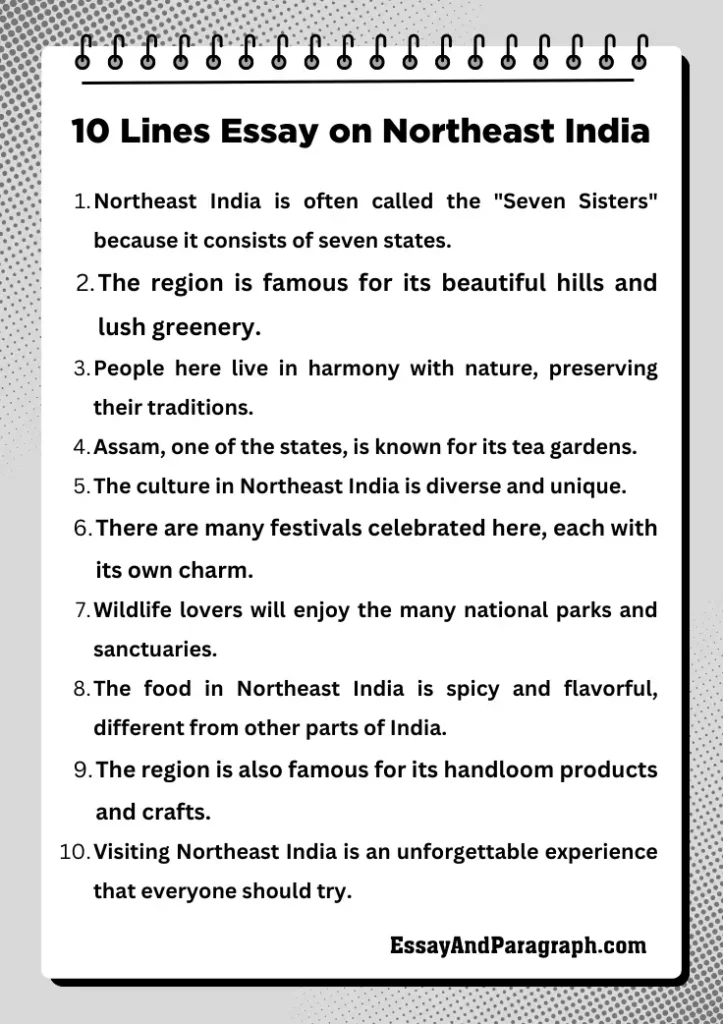Have you ever heard of Northeast India? It’s a part of India that often stays hidden from the eyes of many travelers. Nestled in the northeastern corner, it’s surrounded by natural beauty and unique cultures that make it a hidden gem. This region, made up of states like Assam, Meghalaya, Nagaland, and others, is rich in tradition, wildlife, and landscapes that you won’t find anywhere else in the world. In this article, we will explore what makes Northeast India a place worth discovering.
10 Lines Essay on Northeast India: A Hidden Gem
Northeast India is often called the “Seven Sisters” because it consists of seven states.
The region is famous for its beautiful hills and lush greenery.
People here live in harmony with nature, preserving their traditions.
Assam, one of the states, is known for its tea gardens.
The culture in Northeast India is diverse and unique.
There are many festivals celebrated here, each with its own charm.
Wildlife lovers will enjoy the many national parks and sanctuaries.
The food in Northeast India is spicy and flavorful, different from other parts of India.
The region is also famous for its handloom products and crafts.
Visiting Northeast India is an unforgettable experience that everyone should try.

Short Essay on Northeast India: A Hidden Gem
Northeast India, made up of eight states, is often overlooked when people talk about traveling in India. However, this region is a treasure trove of natural beauty and cultural diversity. One of the key highlights is the state of Assam, famous for its vast tea plantations and the majestic Brahmaputra River. If you ever visit, you will notice the unique culture, where indigenous tribes live in close-knit communities and follow traditions that have been passed down through generations.
Meghalaya, another state in Northeast India, is known as the “Abode of Clouds,” and rightly so, because of its breathtaking landscapes. The hills are covered with dense forests, and the weather is always cool and pleasant. In Nagaland, the people celebrate the Hornbill Festival, where different tribes come together to showcase their colorful dances and traditions.
Beyond the natural beauty, the region is home to a variety of wildlife. Kaziranga National Park in Assam is known for its one-horned rhinoceros and attracts wildlife enthusiasts from all over the world. The food is another important feature of the region. Rich in flavors and spices, the cuisine here is a mix of different influences from the indigenous tribes and neighboring countries like China and Myanmar.
Northeast India is truly a hidden gem, waiting to be discovered by travelers seeking something different from the usual tourist spots.
Long Essay on Northeast India: A Hidden Gem
Northeast India is one of the most unexplored regions of the country, and for those who venture into this part of India, it offers a unique blend of natural beauty, vibrant culture, and diverse communities. Comprising of eight states—Assam, Arunachal Pradesh, Nagaland, Meghalaya, Manipur, Mizoram, Tripura, and Sikkim—Northeast India has long been a hidden gem for travelers who seek a peaceful, off-the-beaten-path experience.
One of the most striking features of Northeast India is its lush greenery. The hills and valleys are covered with forests, offering not only beautiful scenery but also abundant wildlife. Assam, for example, is home to Kaziranga National Park, a UNESCO World Heritage Site, known for its one-horned rhinoceros. Meghalaya, also called the “Abode of Clouds,” is filled with stunning waterfalls, caves, and thick rainforests. The region’s natural beauty is a paradise for nature lovers and photographers alike.
The people of Northeast India are deeply connected to their land and culture. The region is home to many indigenous tribes, each with its own language, traditions, and rituals. In Nagaland, for example, the Hornbill Festival is a grand celebration of the state’s rich cultural heritage, with tribes from all over the region coming together to share their songs, dances, and stories. The festival has become an important event, attracting both locals and tourists alike. In Meghalaya, the unique matrilineal society where lineage is passed down through the mother’s side is a fascinating cultural feature.
The cuisine of Northeast India is another reason to visit. Unlike other parts of India, the food here is less spicy but richer in flavors, often incorporating fresh herbs and a variety of vegetables. Assam’s signature dish, “masor tenga,” a sour fish curry, is a must-try. In Nagaland, you’ll find a variety of meats, including pork, which is often cooked with bamboo shoots. The region’s food is not only delicious but also reflects the cultural diversity of the people who live here.
Apart from the rich culture and breathtaking nature, Northeast India is also known for its vibrant handloom industry. The handwoven textiles of Assam, such as the famous Assam silk, are highly prized and are an integral part of the state’s heritage. The tribal handicrafts of Nagaland and Mizoram also showcase the skill and creativity of the artisans of the region.
Looking ahead, the future of Northeast India as a tourist destination seems bright. With more infrastructure development and promotion of its unique culture and heritage, the region is bound to attract more visitors who are seeking peace, nature, and adventure away from the crowded tourist spots.
FAQs
1. What are the main attractions in Northeast India?
Northeast India is known for its breathtaking landscapes, including lush hills, valleys, and rivers. Some of the main attractions are Kaziranga National Park, the tea gardens of Assam, the Hornbill Festival in Nagaland, and the natural beauty of Meghalaya’s waterfalls and caves. The region’s diverse culture and unique food also make it a great destination.
2. What is the best time to visit Northeast India?
The best time to visit Northeast India is from October to April. During these months, the weather is pleasant, making it ideal for exploring the region’s natural beauty. However, if you enjoy the monsoon season, June to September offers a lush green landscape, though travel can be affected by heavy rains.
3. What is the significance of the Hornbill Festival?
The Hornbill Festival, held in Nagaland, is one of the biggest cultural events in Northeast India. It is a celebration of the region’s diverse tribal cultures, featuring traditional dances, songs, and food. The festival attracts tourists from all over the world who come to experience the vibrant culture and traditions of the Nagas.
4. How is the food in Northeast India different from the rest of India?
The food in Northeast India is known for its simplicity and use of fresh ingredients. Unlike the rest of India, where food is often spicy, Northeast Indian food tends to have a milder, more earthy flavor, often incorporating herbs, bamboo shoots, and fermented products.
5. What are the cultural highlights of Northeast India?
Northeast India is home to a variety of cultures and tribes, each with its own unique traditions. The region celebrates many festivals, such as Bihu in Assam, the Hornbill Festival in Nagaland, and Wangala in Meghalaya. These festivals showcase traditional dances, music, and rituals, offering visitors a glimpse into the rich cultural heritage of the area.
6. How is Northeast India important to the economy of India?
Northeast India plays a significant role in India’s economy, especially in sectors like tea production, agriculture, and handloom. Assam is known for its tea gardens, while Nagaland and Mizoram are famous for their handwoven textiles. The region also has significant potential in eco-tourism and hospitality industries.
Top 5 Quotes on Northeast India
“Northeast India is a land of unspoiled beauty, waiting to be discovered.”
“The culture of Northeast India is a mirror to its diverse and beautiful landscapes.”
“In the hills of Northeast India, every step is a journey into nature’s embrace.”
“The charm of Northeast India lies not just in its beauty but in the warmth of its people.”
“Northeast India is where the heart finds its peace, and the soul feels at home.”
Summary
Northeast India is a region rich in beauty, culture, and heritage. Often hidden from the spotlight, it offers a unique experience that combines stunning landscapes with diverse cultures. From the tea gardens of Assam to the tribal festivals in Nagaland, the region is a treasure trove of experiences for any traveler. Its vibrant food, traditions, and natural wonders make it a perfect destination for those seeking a deeper connection with nature and culture. Exploring Northeast India is like uncovering a hidden gem, offering memories that last a lifetime.




